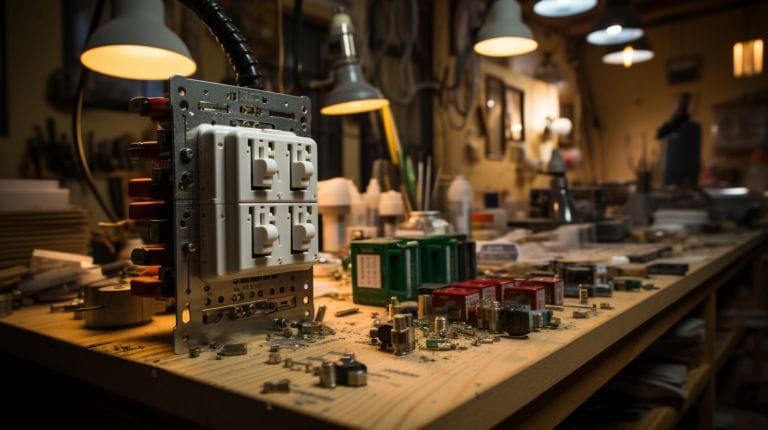Wire a Starter Solenoid: Mastering Starter Connections
How to wire a starter solenoid can seem like a complex puzzle requiring patience, precision, and a solid understanding of the engine’s electrical system. We’ve all found ourselves puzzled in front of a vehicle with a faulty ignition, wondering how such a small component like a starter solenoid, vital for turning the pinion gear, can bring everything to a standstill.
This guide will not only shed light on this intricate process but also guide you through mastering starter connections. However, before you start racing towards your jack and other tools, let’s cover some essential groundwork about the polarity of the system.
Key Takeaways
- The starter solenoid is a high-current switch that connects the starter motor to the battery.
- Secure connections, proper alignment of the piston and regular maintenance are important for optimal performance of the starter solenoid.
- Necessary tools for wiring the starter solenoid include a wire stripper, screwdrivers, a multimeter, and an ability to hot wire.
- Testing the newly installed starter solenoid and troubleshooting potential issues are crucial for a successful operation.
Understanding the Function of a Starter Solenoid in a Vehicle’s Starting System

The starter solenoid, often an unnoticed component, plays a crucial role by utilizing the magnetic field in a vehicle’s starting system. It is essentially a high-current switch that safely connects the starter motor to the battery when you turn the ignition key to operate the system. The solenoid acts as a bridge in the automobile, facilitating electricity flow from the battery to the starter motor, which in turn enables the engine to engage with the flywheel and fire up.
For the starter solenoid to operate optimally, the connections of the solenoid must be secure. A loose wire can lead to problems, including a no-start condition or intermittent starting issues. Regular checks, tightening the connections to the spring disc, and maintenance of these connections contribute to the overall health of your vehicle’s starting system and crankshaft.
Preparing to Wire the Starter Solenoid: Tools and Safety Measures

Before delving into the wiring and replacement process of the faulty starter solenoid, it’s crucial to gather the required tools, understand the safety measures, and the role of the neutral safety switch. You’ll need a wire stripper for preparing the wire connections, a set of screwdrivers for the removal and installation of the solenoid, a multimeter for testing the connections, and a jack to aid the process.
Safety is paramount. Always disconnect the battery terminal before starting to prevent any risk of electric shock. Ensure you are working in a well-ventilated area to avoid the buildup of harmful fumes, and wear safety glasses to protect your eyes from potential flying debris.
Step-by-Step Guide through the Wiring Process of a Starter Solenoid

This guide will walk you through the process of wiring a starter solenoid, from locating the solenoid to connecting the wires and testing the new installation.
- Locating the Starter Solenoid: Identify the starter solenoid attached to the starter motor, usually marked by a large red wire connected to the battery’s positive terminal.
- Disconnecting the Original Solenoid: Begin replacement by disconnecting the battery to prevent accidental shocks, then remove the piston associated with the large red wire that connects the solenoid.
- Connecting the New Starter Solenoid: Using the cloom, reconnect the large red hot wire back to the solenoid and reattach the smaller wires, ensuring they match the original setup.
Remember, keeping track of your starter connections is crucial for the successful operation of your vehicle’s starter motor.
Testing the Newly Installed Starter Solenoid

After securing each wire with the help of a wrench, test the newly installed starter solenoid and watch for turns of the pinion gear to ensure everything is functioning correctly. Check the starting system’s field coils for proper function by turning the ignition, listening for the starter solenoid’s characteristic click, and ensuring voltage is reaching the solenoid and causing the armature to spin.
Should any issues emerge, troubleshoot potential failures with the starter relay and circuit, inspect the wiring paying specific regard to the cable connections for any signs of wear or black or greenish-yellow damage.
Maintenance Tips and Best Practices for a Healthy Starting System

To maintain the peak performance of your starting system, including the gear drive and camshaft attached to the starter solenoid, adhere to regular maintenance and stay vigilant for signs of a failing starter solenoid.
If you encounter any issues while replacing or dealing with the faulty starter, from hot wiring to managing the magnetic field, don’t hesitate to contact professional help. Automobile mechanics have the necessary tools and knowledge to diagnose and fix any issues with your starter wiring and replace the faulty starter solenoid.
Conclusion
We’ve successfully educated you on the process of wiring a starter solenoid, including the installation of a resistor and one-way clutch to ensure optimal performance.
Although it’s not always an easy task, but with a well-trained driver and the right tools, rotating the starter’s pinion gear system is doable.
Remember, testing your work is crucial.
Don’t forget to maintain items like your lever fork, ignition coil, insulated brushes, and armature windings alongside your starting system regularly to avoid future issues.
We hope this guide has been helpful.
Remember, we’re here for all your car maintenance needs.
Safe driving, everyone!
Frequently Asked Questions
What is the function of a starter solenoid?
A starter solenoid acts as a relay between the battery and the starter motor. When the ignition key is turned to the “start” position, the solenoid sends power to the starter and, in turn, starts the engine.
How do I wire a starter solenoid?
To wire a starter solenoid, connect the positive battery cable, which cable connects to the large terminal on the solenoid using a wrench. Then, connect one small wire to the ignition switch and the other small wire to the big terminals of the starter using a wrench.
What are the common terminal connections on a starter solenoid?
The most common terminal connections on a starter solenoid are the battery positive cable terminal, the ignition switch terminal, and the starter motor terminal.
How does a gear-reduction starter differ from a direct-drive starter?
A gear-reduction starter uses gears to reduce the speed of the armature, providing more torque for cranking the crankshaft. In a direct-drive starter, the field coils and armature in the armature and the motor itself are connected directly to the starter motor, bypassing the requirement for additional gears.
What is the role of the starter relay in a starter system?
The starter relay controls the flow of electricity from the battery to the starter motor. The ignition switch triggers the circuit which, upon receiving an electromagnetic input, activates the starter solenoid to engage the field coils and armature initiating the start-up process.







